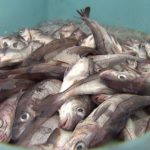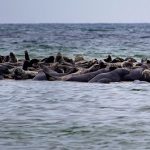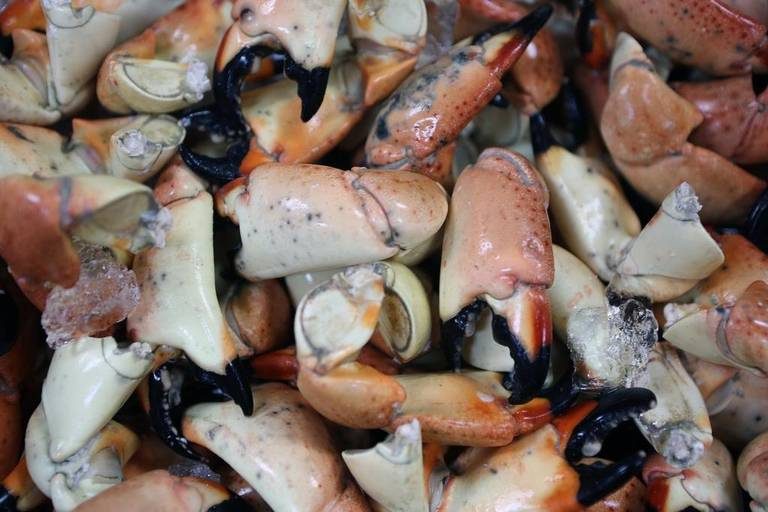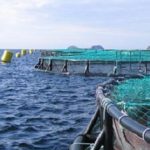Tag Archives: International Pacific Halibut Commission
In advance of its annual meeting in Victoria, British Columbia, Jan. 23-27, IPHC posts catch limit proposals
 In advance of its annual meeting in Victoria, British Columbia, Jan. 23-27, the International Pacific Halibut Commission accepted proposals through Dec. 31 on catch limits or harvest advice. Of the eight proposals noted so far by the IPHC, six were specific to Area 2C in Southeast Alaska, including one from a group of processors and fishing associations who contend that reductions in Area 2C catch limits are not justified by current data or trends. Area 2C stocks are increasing at current harvest rates, and the Area 2C survey weight per unit of effort is higher than any other IPHC area coast-wide, the proposal said. The document was signed by Kathy Hansen, Southeast Alaska Fishermen’s Alliance; Megan O’Neil, Petersburg Vessel Owner’s Association; Dale Kelley, Alaska Trollers Association; Dan Falvey, Alaska Longline Fishermen’s Association Joe Morrelli, Seafood Producers Cooperative; Don Spigelmyer, Icicle Seafoods; and Mike Erickson, Alaska Glacier Seafoods. Read the rest here 09:40
In advance of its annual meeting in Victoria, British Columbia, Jan. 23-27, the International Pacific Halibut Commission accepted proposals through Dec. 31 on catch limits or harvest advice. Of the eight proposals noted so far by the IPHC, six were specific to Area 2C in Southeast Alaska, including one from a group of processors and fishing associations who contend that reductions in Area 2C catch limits are not justified by current data or trends. Area 2C stocks are increasing at current harvest rates, and the Area 2C survey weight per unit of effort is higher than any other IPHC area coast-wide, the proposal said. The document was signed by Kathy Hansen, Southeast Alaska Fishermen’s Alliance; Megan O’Neil, Petersburg Vessel Owner’s Association; Dale Kelley, Alaska Trollers Association; Dan Falvey, Alaska Longline Fishermen’s Association Joe Morrelli, Seafood Producers Cooperative; Don Spigelmyer, Icicle Seafoods; and Mike Erickson, Alaska Glacier Seafoods. Read the rest here 09:40
Southeast halibut catch limit may drop in 2017
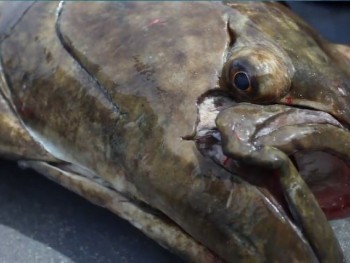 The International Pacific Halibut Commission is considering a cut of 870,000 pounds to Southeast Alaska’s 2017 halibut quota. The IPHC, the joint Canadian-American body that sets annual halibut harvests, concluded its interim meeting Nov. 30 in Seattle. The IPHC will set the 2017 quota at its 93rd annual meeting from Jan. 23 to Jan. 27 in Victoria, B.C. During the interim meeting, IPHC staff recommended that the entire North Pacific halibut catch be reduced from 29.89 million pounds to 26.12 million pounds. Most of the reduction would fall in the eastern portion of the Gulf of Alaska and in Pacific Canada. Read the story here 09:50
The International Pacific Halibut Commission is considering a cut of 870,000 pounds to Southeast Alaska’s 2017 halibut quota. The IPHC, the joint Canadian-American body that sets annual halibut harvests, concluded its interim meeting Nov. 30 in Seattle. The IPHC will set the 2017 quota at its 93rd annual meeting from Jan. 23 to Jan. 27 in Victoria, B.C. During the interim meeting, IPHC staff recommended that the entire North Pacific halibut catch be reduced from 29.89 million pounds to 26.12 million pounds. Most of the reduction would fall in the eastern portion of the Gulf of Alaska and in Pacific Canada. Read the story here 09:50
Halibut stock stable, flat harvest likely
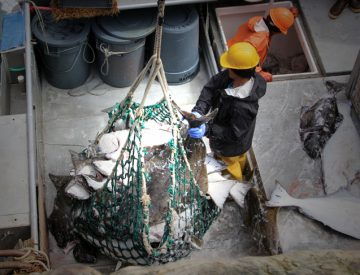 Stocks have stabilized and bycatch is as low as it’s been since 1960, however the halibut quota for next year will edge down after being raised for the first time in years in 2016. The International Pacific Halibut Commission held its interim meeting in Seattle Nov. 29-30 to review the 2016 catch, status of the stock, and to recommend how much halibut fishermen will be able to take in 2017. Overall, biologists and managers gave a view of a responsible group of users responding well to a trough in the historical ups and downs of halibut abundance, which has flattened after a decade of downward movement. IPHC biologist Dr. Ian Stewart painted a more secure picture of halibut than the last two years have seen, emphasizing decreased bycatch and a firm outlook for abundance. “I think it’s pretty clear that we’ve seen the stock stabilize,” Stewart said. Read the story here 15:42
Stocks have stabilized and bycatch is as low as it’s been since 1960, however the halibut quota for next year will edge down after being raised for the first time in years in 2016. The International Pacific Halibut Commission held its interim meeting in Seattle Nov. 29-30 to review the 2016 catch, status of the stock, and to recommend how much halibut fishermen will be able to take in 2017. Overall, biologists and managers gave a view of a responsible group of users responding well to a trough in the historical ups and downs of halibut abundance, which has flattened after a decade of downward movement. IPHC biologist Dr. Ian Stewart painted a more secure picture of halibut than the last two years have seen, emphasizing decreased bycatch and a firm outlook for abundance. “I think it’s pretty clear that we’ve seen the stock stabilize,” Stewart said. Read the story here 15:42
Prices for commercial halibut shares reach jaw-dropping level
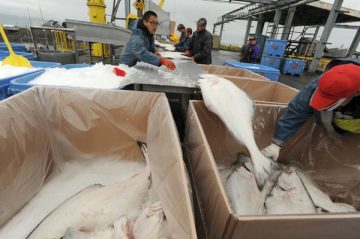 As Alaska’s iconic halibut fishery wraps up this week, stakeholders are holding their breath to learn if the catch limit might ratchet up slightly once again in 2017. Meanwhile, prices for hard-to-get shares of the halibut catch are jaw-dropping. The halibut fishery ends Monday for nearly 2,000 longliners who hold halibut IFQs (Individual Fishing Quotas). The Alaska fishery will produce a catch of more than 20 million pounds if the fleet reaches its limit. Last year, the halibut haul was worth nearly $110 million at the Alaska docks. For the first time in several decades, the coast-wide Pacific halibut harvest numbers increased this year by 2.3 percent to nearly 30 million pounds. Along with Alaska, the eight-month fishery includes the Pacific Coast states and British Columbia. Read the story here 09:07
As Alaska’s iconic halibut fishery wraps up this week, stakeholders are holding their breath to learn if the catch limit might ratchet up slightly once again in 2017. Meanwhile, prices for hard-to-get shares of the halibut catch are jaw-dropping. The halibut fishery ends Monday for nearly 2,000 longliners who hold halibut IFQs (Individual Fishing Quotas). The Alaska fishery will produce a catch of more than 20 million pounds if the fleet reaches its limit. Last year, the halibut haul was worth nearly $110 million at the Alaska docks. For the first time in several decades, the coast-wide Pacific halibut harvest numbers increased this year by 2.3 percent to nearly 30 million pounds. Along with Alaska, the eight-month fishery includes the Pacific Coast states and British Columbia. Read the story here 09:07
Following his exit from the IPHC, Kauffman calls violation ‘honest mistake’
 An executive from a Community Development Quota group blamed a regulatory mix-up for the fishing violation that forced him to resign from the international commission regulating halibut harvests. The National Oceanic and Atmospheric Administration Office of Law Enforcement charged Jeff Kauffman and two other men in March with possessing more than 10,000 pounds of halibut over their combined quota limits for a violation that occurred in June 2012. Kauffman is the vice president of the Central Bering Sea Fisherman’s Association, the Community Development Quota group for the island of St. Paul. He resigned on June 22. The joint U.S.-Canadian body has governed halibut quotas and regulations by international treaty since 1923, and has three commissioners each from the U.S. and Canada. Kauffman chalked the violation up to a regulatory mix-up. The violation occurred around June 5, 2012, while Kauffman fished for halibut around St. Paul with Mike Baldwin and Wade Henley, the captain of the F/V Saint Peter. CBSFA owns 100 percent of the vessel. Read the story here 14:49
An executive from a Community Development Quota group blamed a regulatory mix-up for the fishing violation that forced him to resign from the international commission regulating halibut harvests. The National Oceanic and Atmospheric Administration Office of Law Enforcement charged Jeff Kauffman and two other men in March with possessing more than 10,000 pounds of halibut over their combined quota limits for a violation that occurred in June 2012. Kauffman is the vice president of the Central Bering Sea Fisherman’s Association, the Community Development Quota group for the island of St. Paul. He resigned on June 22. The joint U.S.-Canadian body has governed halibut quotas and regulations by international treaty since 1923, and has three commissioners each from the U.S. and Canada. Kauffman chalked the violation up to a regulatory mix-up. The violation occurred around June 5, 2012, while Kauffman fished for halibut around St. Paul with Mike Baldwin and Wade Henley, the captain of the F/V Saint Peter. CBSFA owns 100 percent of the vessel. Read the story here 14:49
Alaska IPHC board member fined $49K for fishing violation, resigns
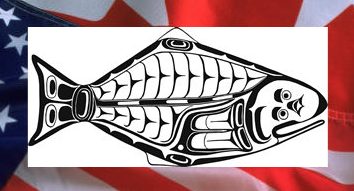 Jeff Kauffman resigned as the Alaska resident member of the International Pacific Halibut Commission on June 22, shortly after he and two fellow fishermen agreed to a $49,000 fine for harvesting more than 10,000 pounds of halibut over their combined quota limit in June 2012. The settlement the National Oceanic and Atmospheric Administration Office of Law Enforcement agreed to was nearly $13,000 less than the original Notice of Violation and Assessment of $61,781 issued on March 1 of this year. Kauffman, who is the vice president of the Central Bering Sea Fisherman’s Association, or CBSFA, and a member of the Advisory Panel to the North Pacific Fishery Management Council, did not respond to a request for comment. Interesting article that should raise some questions regarding conflicting relationships. Read the story here 08:40
Jeff Kauffman resigned as the Alaska resident member of the International Pacific Halibut Commission on June 22, shortly after he and two fellow fishermen agreed to a $49,000 fine for harvesting more than 10,000 pounds of halibut over their combined quota limit in June 2012. The settlement the National Oceanic and Atmospheric Administration Office of Law Enforcement agreed to was nearly $13,000 less than the original Notice of Violation and Assessment of $61,781 issued on March 1 of this year. Kauffman, who is the vice president of the Central Bering Sea Fisherman’s Association, or CBSFA, and a member of the Advisory Panel to the North Pacific Fishery Management Council, did not respond to a request for comment. Interesting article that should raise some questions regarding conflicting relationships. Read the story here 08:40
Alaska commercial halibut quota goes up for first time in 15 years
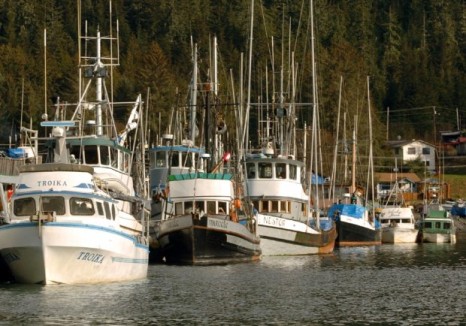 Alaska halibut stocks are showing signs of an uptick, and for the first time in 15 years, commercial fishermen’s catches will not be slashed this year. Fishery managers on Friday set the coastwide Pacific halibut harvest at 29.89 million pounds, a . Because halibut paid more than $6 a pound at the docks last year, even a small increase can be lucrative. Bowen said it could push the price for halibut quota share to $60 a pound in major fishing region. That equates to $90,000 for a small lot of 1,500 pounds. Read the article here 08:14
Alaska halibut stocks are showing signs of an uptick, and for the first time in 15 years, commercial fishermen’s catches will not be slashed this year. Fishery managers on Friday set the coastwide Pacific halibut harvest at 29.89 million pounds, a . Because halibut paid more than $6 a pound at the docks last year, even a small increase can be lucrative. Bowen said it could push the price for halibut quota share to $60 a pound in major fishing region. That equates to $90,000 for a small lot of 1,500 pounds. Read the article here 08:14
Halibut commission boosts coast-wide catch limit
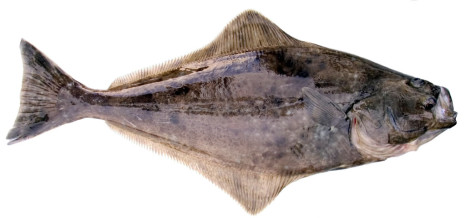 The International Pacific Halibut Commission Friday approved an increase in halibut catch limits for most of the coast. The joint U.S. and Canadian body oversees management of the prized bottom fish from California to Alaska. The commission held its annual meeting in Juneau last week. Commissioners approved a coast-wide catch of just under 30 million pounds for 2016. That’s an increase of two point two percent from last year’s limits. Commissioner chair Jim Balsiger of Juneau said the decisions were not easy to make. Read the post here 09:59
The International Pacific Halibut Commission Friday approved an increase in halibut catch limits for most of the coast. The joint U.S. and Canadian body oversees management of the prized bottom fish from California to Alaska. The commission held its annual meeting in Juneau last week. Commissioners approved a coast-wide catch of just under 30 million pounds for 2016. That’s an increase of two point two percent from last year’s limits. Commissioner chair Jim Balsiger of Juneau said the decisions were not easy to make. Read the post here 09:59
International Pacific Halibut Commission tackles catch limits in Juneau meeting
 The commission manages fishing and research on the valuable bottom fish from Alaska to California. IPHC scientist Ian Stewart this week presented some more optimistic news on the status of halibut. “The bottom line for this year is that we can see some positive trends both in the data and in the stock assessment models,” Stewart said. “The stock appears to be stabilizing at a coast-wide level and the more years that we’ve see this play out, the more certain we become of that.” Read the article here 12:35
The commission manages fishing and research on the valuable bottom fish from Alaska to California. IPHC scientist Ian Stewart this week presented some more optimistic news on the status of halibut. “The bottom line for this year is that we can see some positive trends both in the data and in the stock assessment models,” Stewart said. “The stock appears to be stabilizing at a coast-wide level and the more years that we’ve see this play out, the more certain we become of that.” Read the article here 12:35
User conflicts over halibut, salmon on horizon for 2016
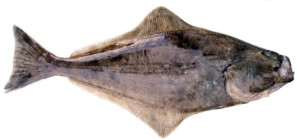 The year about to end saw the beginnings of some fisheries regulations and legal battles that will either resolve or present further issues in 2016. Halibut has dominated the federal fisheries agenda for the North Pacific Fishery Management Council, which oversees the Exclusive Economic Zone from 3 to 200 miles off the coast. Shrinking halibut stocks and dual management have collided to produce a fishery bitterly divided among bycatch users, directed users, and charter anglers struggling to make ends meet with fewer legally harvestable fish. Read the article here 16:04
The year about to end saw the beginnings of some fisheries regulations and legal battles that will either resolve or present further issues in 2016. Halibut has dominated the federal fisheries agenda for the North Pacific Fishery Management Council, which oversees the Exclusive Economic Zone from 3 to 200 miles off the coast. Shrinking halibut stocks and dual management have collided to produce a fishery bitterly divided among bycatch users, directed users, and charter anglers struggling to make ends meet with fewer legally harvestable fish. Read the article here 16:04
YEAR IN REVIEW: Federal agenda dominated by halibut bycatch concerns
Halibut  dominated the federal fisheries process in 2015, with each sector fighting over reduced allocations. Directed halibut fishermen in the North Pacific have watched their quotas drop while the trawl industry prosecuting Bering Sea groundfish has had a relatively static bycatch limit for 20 years. The North Pacific Fishery Management Council governs bycatch while the International Pacific Halibut Commission governs directed removals, and the two have not coordinated on the decline in harvestable halibut biomass. Read the article here 08:38
dominated the federal fisheries process in 2015, with each sector fighting over reduced allocations. Directed halibut fishermen in the North Pacific have watched their quotas drop while the trawl industry prosecuting Bering Sea groundfish has had a relatively static bycatch limit for 20 years. The North Pacific Fishery Management Council governs bycatch while the International Pacific Halibut Commission governs directed removals, and the two have not coordinated on the decline in harvestable halibut biomass. Read the article here 08:38
International Pacific Halibut Commission weighs 2016 harvest recommendations
 The interim meeting of the International Pacific Halibut Commission is our first look at the huge volume of data the collects that informs a big decision coming next January: How much halibut will be available for harvest from the coast of Oregon to the Bering Sea. For halibut users in Southeast Alaska, the number could be ticking up — maybe 8-percent, or by over 300,000 pounds. In Southcentral Alaska, though, the trend is the other direction — the commercial and sport fleets may see their harvests reduced by 7-percent, or three-quarters of a million pounds. Read the article here 14:05
The interim meeting of the International Pacific Halibut Commission is our first look at the huge volume of data the collects that informs a big decision coming next January: How much halibut will be available for harvest from the coast of Oregon to the Bering Sea. For halibut users in Southeast Alaska, the number could be ticking up — maybe 8-percent, or by over 300,000 pounds. In Southcentral Alaska, though, the trend is the other direction — the commercial and sport fleets may see their harvests reduced by 7-percent, or three-quarters of a million pounds. Read the article here 14:05
IPHC staff reflect on 2015 season, decisions, with Joe Viechnicki
 A little over a month from now, the International Pacific Halibut Commission will meet to start considering catch limits for next season. IPHC executive director Bruce Leaman and visited Petersburg this week and met with commercial fishermen. Joe Viechnicki sat down with the two and asked Stewart about what he’s heard about this past season. IPHC staff will be presenting preliminary numbers for next year’s catch to the commission at an interim meeting in Seattle December 1st and 2nd. Audio here, duration: 11:37 14:31
A little over a month from now, the International Pacific Halibut Commission will meet to start considering catch limits for next season. IPHC executive director Bruce Leaman and visited Petersburg this week and met with commercial fishermen. Joe Viechnicki sat down with the two and asked Stewart about what he’s heard about this past season. IPHC staff will be presenting preliminary numbers for next year’s catch to the commission at an interim meeting in Seattle December 1st and 2nd. Audio here, duration: 11:37 14:31
“State of Our Halibut” discussed at last weekend’s inaugural Homer Halibut Festival – It’s not good.
 From a fun run to a fish fry to a halibut cabaret, most of the weekend was a celebration of Homer’s iconic resource. But much of the discussion at Saturday’s “State of Our Halibut” lecture series at the Alaska Islands and Ocean Visitor Center was serious and centered around a major issue: the total mass of Pacific halibut is shrinking and no one is entirely sure why or what to do about it. That’s not entirely new information. Nearly ever year of the past decade, the annual survey reported decreases in both Pacific halibut population and biomass,,, Read the rest here 09:15
From a fun run to a fish fry to a halibut cabaret, most of the weekend was a celebration of Homer’s iconic resource. But much of the discussion at Saturday’s “State of Our Halibut” lecture series at the Alaska Islands and Ocean Visitor Center was serious and centered around a major issue: the total mass of Pacific halibut is shrinking and no one is entirely sure why or what to do about it. That’s not entirely new information. Nearly ever year of the past decade, the annual survey reported decreases in both Pacific halibut population and biomass,,, Read the rest here 09:15
NOAA Seeks Letters of Public Support for International Pacific Halibut Commission (IPHC) Nominees
 NOAA Fisheries is seeking letters of public support for nominees (listed below) for two presidential appointments to serve as U.S. Commissioners to the International Pacific Halibut Commission. The IPHC is a bilateral regional fishery management organization established between Canada and the United States for the management of the Pacific halibut fishery. Terms expire for the current commissioners December 31, 2015. Commissioners are eligible for reappointment. Of the two appointees, one must be a resident of Alaska and the other shall be a nonresident of Alaska. Read the rest here 16:48
NOAA Fisheries is seeking letters of public support for nominees (listed below) for two presidential appointments to serve as U.S. Commissioners to the International Pacific Halibut Commission. The IPHC is a bilateral regional fishery management organization established between Canada and the United States for the management of the Pacific halibut fishery. Terms expire for the current commissioners December 31, 2015. Commissioners are eligible for reappointment. Of the two appointees, one must be a resident of Alaska and the other shall be a nonresident of Alaska. Read the rest here 16:48
Halibut bycatch cap reduction should reflect what we know about the resource
 As a fishery scientist who has worked for more than 20 years with trawl fishermen to reduce salmon, crab and halibut bycatch, I find the recent rhetoric around proposed North Pacific Fisheries Management Council changes to the cap very frustrating. In particular, I hear media campaigns underwritten by environmental NGOs claiming, “It’s been 20 years since the halibut bycatch cap was last reduced,” implying that this has created a conservation issue. Read the rest here 14:28
As a fishery scientist who has worked for more than 20 years with trawl fishermen to reduce salmon, crab and halibut bycatch, I find the recent rhetoric around proposed North Pacific Fisheries Management Council changes to the cap very frustrating. In particular, I hear media campaigns underwritten by environmental NGOs claiming, “It’s been 20 years since the halibut bycatch cap was last reduced,” implying that this has created a conservation issue. Read the rest here 14:28
NMFS seeks nominations for U.S. seats on the International Pacific Halibut Commission
 National Marine Fisheries Service is seeking nominations to fill two non-NOAA commissioner seats on the International Pacific Halibut Commission. Terms for the current commissioners—who are eligible for reappointment—expire on December 31, 2015. One must be a resident of Alaska—currently held by Donald Lane from Homer, Alaska One must be a non-resident of Alaska—currently held by Robert Alverson of Washington State. Read the rest here 12:09
National Marine Fisheries Service is seeking nominations to fill two non-NOAA commissioner seats on the International Pacific Halibut Commission. Terms for the current commissioners—who are eligible for reappointment—expire on December 31, 2015. One must be a resident of Alaska—currently held by Donald Lane from Homer, Alaska One must be a non-resident of Alaska—currently held by Robert Alverson of Washington State. Read the rest here 12:09
2015 charter and commercial halibut management measures announced
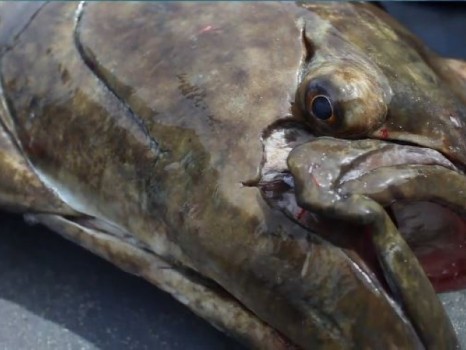 NMFS is providing notice of the immediate effect of regulations of the International Pacific Halibut Commission (IPHC). The commercial IFQ halibut season opens Saturday, March 14, 2015. At its annual meeting in January, the IPHC recommended to the governments of Canada and the United States catch limits for 2015 totaling 29,223,000 pounds. Read the rest here 07:23
NMFS is providing notice of the immediate effect of regulations of the International Pacific Halibut Commission (IPHC). The commercial IFQ halibut season opens Saturday, March 14, 2015. At its annual meeting in January, the IPHC recommended to the governments of Canada and the United States catch limits for 2015 totaling 29,223,000 pounds. Read the rest here 07:23
Following a decade of decline, halibut harvest will increase in 2015
 In 2004, the coastwide Pacific halibut catch limit was 76.5 million pounds. By 2014, that had been cut 64 percent to 27.5 million pounds. On Jan. 30, the commission, an international U.S.-Canadian body that governs directed halibut fisheries, set the quotas for commercial and charter halibut industries at 29.2 million pounds total coastwide catch, 22 million pounds of which goes to the Alaska waters. The 2015 harvest limit is 6 percent more than last year. Read the rest here 18:28
In 2004, the coastwide Pacific halibut catch limit was 76.5 million pounds. By 2014, that had been cut 64 percent to 27.5 million pounds. On Jan. 30, the commission, an international U.S.-Canadian body that governs directed halibut fisheries, set the quotas for commercial and charter halibut industries at 29.2 million pounds total coastwide catch, 22 million pounds of which goes to the Alaska waters. The 2015 harvest limit is 6 percent more than last year. Read the rest here 18:28
Alaska halibut fishermen granted quota increase
 Fishermen in Alaska will have access to slightly more halibut this year than last. The International Pacific Halibut Commission voted Friday in Vancouver, British Columbia, for a total catch in Alaska of 21.215 million pounds, up from 19.705 million pounds in 2014. That’s the first time in a decade the commission has increased the catch. Read the rest here 20:23
Fishermen in Alaska will have access to slightly more halibut this year than last. The International Pacific Halibut Commission voted Friday in Vancouver, British Columbia, for a total catch in Alaska of 21.215 million pounds, up from 19.705 million pounds in 2014. That’s the first time in a decade the commission has increased the catch. Read the rest here 20:23
2015 IPHC Annual Meeting – Monday, January 26 through Friday, January 30, 2015 – Listen via Webinar
The Ninety-First Annual Meeting of the  will be held from Monday, January 26 through Friday, January 30, 2015 at the Vancouver Marriott Pinnacle Downtown Hotel in Vancouver, British Columbia. This year’s meeting is scheduled to open on Monday with presentations on the fishery, the 2014 stock assessment, and the harvest decision table, and conclude on Friday with Commission approval of catch limits and regulations. All public sessions and administrative sessions will be open to the public. These open sessions will also be webcast. Read the rest here, webinar links. 17:30
will be held from Monday, January 26 through Friday, January 30, 2015 at the Vancouver Marriott Pinnacle Downtown Hotel in Vancouver, British Columbia. This year’s meeting is scheduled to open on Monday with presentations on the fishery, the 2014 stock assessment, and the harvest decision table, and conclude on Friday with Commission approval of catch limits and regulations. All public sessions and administrative sessions will be open to the public. These open sessions will also be webcast. Read the rest here, webinar links. 17:30
Canada-U.S. delegates meet in B.C. to discuss halibut ‘wastage’ in Bering Sea
 You might say it’s a story about the fish that didn’t get away. Fishermen in the Bering Sea off the coast of Alaska are tossing back millions of kilograms of dead halibut they’ve caught unintentionally while scooping up other stocks. The longtime practice, known as bycatch, has become the focus of intense scrutiny in Alaska and will be the subject of debate at a meeting at month’s end of the International Pacific Halibut Commission in Vancouver. Read the rest here 11:13
You might say it’s a story about the fish that didn’t get away. Fishermen in the Bering Sea off the coast of Alaska are tossing back millions of kilograms of dead halibut they’ve caught unintentionally while scooping up other stocks. The longtime practice, known as bycatch, has become the focus of intense scrutiny in Alaska and will be the subject of debate at a meeting at month’s end of the International Pacific Halibut Commission in Vancouver. Read the rest here 11:13

If we don’t protect Alaska halibut, there will be no fish to fight over
The halibut wars are on, folks, and I don’t mean the Domino’s Pizza ad slam from last year. There are a few silly voices trying to make the current arguments regarding halibut an allocation war. Sadly, they are wrong. It’s way past allocation, folks, and now its a fight for preservation and sustainability. Areas of the Bering Sea have not been managed to sustain halibut — specifically Area 4CDE. Read the rest here 13:31
Updates for upcoming halibut commission meeting – tension mounts
 The stage is set for some tension when halibut managers and stakeholders gather later this month in Vancouver. Only one catch limit comment was submitted by the December 31 deadline. To reduce handling and wastage in the fishery, the Seattle-based Fishing Vessel Owners’ Association is asking the IPHC to reduce the minimum size requirement for commercially caught halibut from 32 to 30 inches. Read the rest here 18:51
The stage is set for some tension when halibut managers and stakeholders gather later this month in Vancouver. Only one catch limit comment was submitted by the December 31 deadline. To reduce handling and wastage in the fishery, the Seattle-based Fishing Vessel Owners’ Association is asking the IPHC to reduce the minimum size requirement for commercially caught halibut from 32 to 30 inches. Read the rest here 18:51
Pitted against the hook-and-line halibut fleet are 16 Bering Sea trawlers – Conflict threatens to close Bering Sea halibut fishery
 Those likely to suffer include fishing crews from Alaska to Oregon and vessel owners who invested in the halibut haul after it was privatized in 1995 in a failed bid to stabilize the fish stock. Perhaps more severely threatened are Aleut villages of western Alaska that rely on halibut for both cash and sustenance. The trouble stems from more than a decade of declines in halibut stocks targeted by fishing vessels that use long lines of baited hooks to reel in the popular fish. Read the rest here 17:33
Those likely to suffer include fishing crews from Alaska to Oregon and vessel owners who invested in the halibut haul after it was privatized in 1995 in a failed bid to stabilize the fish stock. Perhaps more severely threatened are Aleut villages of western Alaska that rely on halibut for both cash and sustenance. The trouble stems from more than a decade of declines in halibut stocks targeted by fishing vessels that use long lines of baited hooks to reel in the popular fish. Read the rest here 17:33
Dischner: Another year of halibut quota cuts on the table for 2015 (lots of info)
 Pacific halibut fishermen could have a reduced catch next year if the International Pacific Halibut Commission opts to go with the “blue-line” projection released Dec. 2, but Alaskan fishermen in some areas may see a slightly higher quota than in 2014. The blue-line projection calls for a coastwide catch of about 25.02 million pounds million pounds, and total fishery removals of 38.72 million pounds. Read the rest here 13:12
Pacific halibut fishermen could have a reduced catch next year if the International Pacific Halibut Commission opts to go with the “blue-line” projection released Dec. 2, but Alaskan fishermen in some areas may see a slightly higher quota than in 2014. The blue-line projection calls for a coastwide catch of about 25.02 million pounds million pounds, and total fishery removals of 38.72 million pounds. Read the rest here 13:12
International Pacific Halibut Commission Interim Meeting 2014 – 2-3 December – Attend via Webinar!
 Meeting Documents can be accessed here Interim Meeting 2014 Agenda Webinar registration: 2014 IPHC Interim Meeting Day 1 here 2014 IPHC Interim Meeting Day 2 here 18:47
Meeting Documents can be accessed here Interim Meeting 2014 Agenda Webinar registration: 2014 IPHC Interim Meeting Day 1 here 2014 IPHC Interim Meeting Day 2 here 18:47
Seward tops commercial fisheries – Wolfgang Kurtz
While Homer, Kodiak and Seward continue to compete for the top spot in commercial halibut landings this year, Seward has taken a big lead when sablefish is added into the mix.,,,Between halibut and sablefish, commonly called black cod, Seward has more pounds of fish landed so far this season than Homer and Kodiak combined. Read more here 19:33
Bycatch symposium underway
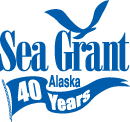 The most common bycatch topics in Alaska — salmon caught by the Bering Sea boats targeting pollock, and halibut caught by Alaska trawlers — were on the table at a fisheries symposium today. Scientists, industry representatives and others interested in fisheries science, management and policy are discussing everything bycatch at the Lowell Wakefield Fisheries Symposium, which runs through Thursday at the Hilton Hotel in Downtown Anchorage. Read more here 17:52
The most common bycatch topics in Alaska — salmon caught by the Bering Sea boats targeting pollock, and halibut caught by Alaska trawlers — were on the table at a fisheries symposium today. Scientists, industry representatives and others interested in fisheries science, management and policy are discussing everything bycatch at the Lowell Wakefield Fisheries Symposium, which runs through Thursday at the Hilton Hotel in Downtown Anchorage. Read more here 17:52

































